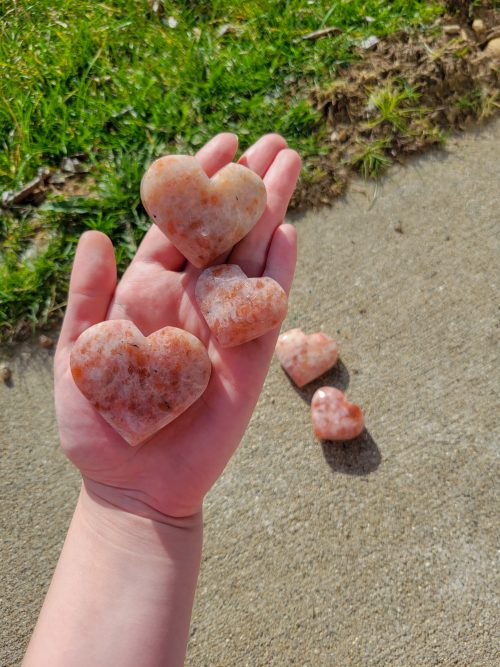-
4.5cm Wide Sunstone is a plagioclase feldspar. The glitter-like sheen in this stone comes from inclusions that are most commonly hematite but can also be goethite, pyrite, or copper (rare). This beautiful stone is formed in molten lava and can be found in many places around the world such as Australia, Canada, China, Congo, India, Mexico, Norway, Russia, Sri Lanka, Tanzania, the U.S. ***Due to natural variations in stones, appearance will vary***
-
5cm Wide Sunstone is a plagioclase feldspar. The glitter-like sheen in this stone comes from inclusions that are most commonly hematite but can also be goethite, pyrite, or copper (rare). This beautiful stone is formed in molten lava and can be found in many places around the world such as Australia, Canada, China, Congo, India, Mexico, Norway, Russia, Sri Lanka, Tanzania, the U.S. ***Due to natural variations in stones, appearance will vary***
-
5cm - 6cm Wide Sodalite is a rare mineral formed inside igneous rocks crystalized as a result of sodium-rich magma. The blue color comes from the rock that Sodalite is formed in; nepheline syenite, trachyte, and phonolite. Although the sodalite-bearing rock is rare, it can most commonly be found in the US, Canada, and Africa. ***Due to natural variations in stones, the appearance will vary***
-
3cm - 4cm Smoky Quartz is found in the veins of igneous and metamorphic rocks. Well-formed smoky quartz is found in the cavities of metamorphic rocks. This mineral's color varies depending on where it is found. In areas where there are radioactive mineral deposits, Smoky Quartz is very dark due to the emissions. Brazil and Madagascar are the world's biggest suppliers of Smoky Quartz. ***Due to natural variations of stones, the appearance will vary***
-
6cm x 5cm x 3cm Serpentine is primarily composed of one or more of the three magnesium silicate minerals: lizardite, chrysotile, and "antigorite. This mineral comes from the Earth's mantle which is just under the Earth's crust. This mineral is the state rock of California but can also be found in Russia, Greece, New Zealand, and many other places. ***Due to natural variations in stones, the appearance will vary***
-
3cm - 4cm Wide Septarian concretions are concretions containing cavities or cracks, called septaria. The septaria are the calcite (yellow) filled cracks at the center of the rock, indicating where the center of the concretions have shrunk, possibly during dehydration during its transformative journey over a long period of time. Septarian can be found mostly in the Gulf of Mexico and Madagascar. ***Due to natural variations in stones, appearance will vary***
-
6cm x 5cm x 2cm Selenite-also known as Satin Spar- is a chemical sedimentary mineral. Unlike carbonate rocks and siliceous rocks, this mineral comes from seawater that evaporates and leaves the chemical found in selenite behind. This beautiful mineral has a pearly, satin-like appearance and is a very soft mineral. These minerals can be found in Mexico, Brazil, Japan, and many other countries! ***Due to natural variations in stones, the appearance will vary***
-
5cm - 6cm Rhodonite is a silicate mineral usually found in metamorphic rocks that are known to have other manganese minerals in them. The manganese is how Rhodonite gets its color. These beautiful minerals can be found in Argentina, Australia, Brazil, Canada, and many other places. ***Due to natural variation in stones, appearance will vary***
-
4.5cm Wide Pink opal is formed by bubbling water near volcanic ash. It dissolves the silica and forms in nodules from volcanic activity. Most specimens contain pink opal mixed with minerals such as rhyolite. These beautiful specimens are only found in Peru and Australia. ***Due to natural variations in stones, appearance will vary***
-
5cm Wide Pink opal is formed by bubbling water near volcanic ash. It dissolves the silica and forms in nodules from volcanic activity. Most specimens contain pink opal mixed with minerals such as rhyolite. These beautiful specimens are only found in Peru and Australia. ***Due to natural variations in stones, appearance will vary***
-
7.5cm Wide Ocean jasper is a rare and colorful material exclusively from Madagascar. It is described as a variety of Orbicular Jasper due to its orb-like inclusions. Ocean jasper is a name for what is known to be a spherulitic chalcedony which is a cryptocrystalline variety of quartz. Cryptocrystalline is a term that means its crystals are too small to be seen with the naked eye. ***Due to natural variations in stones, appearance will vary***










